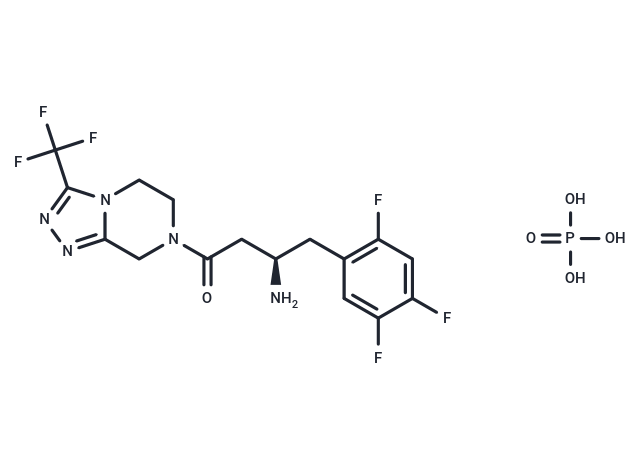Shopping Cart
- Remove All
 Your shopping cart is currently empty
Your shopping cart is currently empty

Sitagliptin phosphate (MK-0431 phosphate) is a dipeptidyl peptidase-4 (DPP4) inhibitor.

| Pack Size | Price | Availability | Quantity |
|---|---|---|---|
| 50 mg | $33 | In Stock | |
| 100 mg | $47 | In Stock | |
| 200 mg | $57 | In Stock | |
| 500 mg | $94 | In Stock | |
| 1 mL x 10 mM (in DMSO) | $52 | In Stock |
| Description | Sitagliptin phosphate (MK-0431 phosphate) is a dipeptidyl peptidase-4 (DPP4) inhibitor. |
| Targets&IC50 | DPP4:19 nM |
| In vitro | In vitro: Sitagliptin was a potent inhibitor for DPP-4 with an IC50 of 18 nM. Sitagliptin inhibited DPP-8 (IC50: 48 μM). Sitagliptin showed no effect on several related peptidases, including DPP-9, DPP-II, and aminopeptidase P [1]. |
| In vivo | In free-fed Han-Wistar rats, the ED50 values ??for the inhibition of plasma DPP-4 activity by sitagliptin phosphate were calculated as 7 hours post-dose at 2.3 mg/kg and 24 hours post-dose at 30 mg/kg [1]. A mouse model of streptozotocin-induced type 1 diabetes showed elevated plasma DPP-4 levels, which was significantly suppressed in mice on a sitagliptin phosphate diet. This is achieved through a positive effect on hyperglycemia regulation, possibly by prolonging islet graft survival. The plasma clearance and volume of distribution of sitagliptin phosphate in rats (40-48 mL/min/kg, 7-9 L/kg) were higher than those in dogs (9 mL/min/kg, 3 L/kg); its The half-life is shorter in rats, 2 hours in dogs and 4 hours in dogs[2]. |
| Alias | Sitagliptin (phosphate), MK-0431 phosphate, Januvia |
| Molecular Weight | 505.31 |
| Formula | C16H18F6N5O5P |
| Cas No. | 654671-78-0 |
| Smiles | N[C@@H](CC(N1Cc2nnc(C(F)(F)F)n2CC1)=O)Cc(c(F)c1)cc(F)c1F.OP(O)(O)=O |
| Relative Density. | no data available |
| Storage | Powder: -20°C for 3 years | In solvent: -80°C for 1 year | Shipping with blue ice. | ||||||||||||||||||||||||||||||
| Solubility Information | DMSO: 50 mg/mL (98.95 mM), Sonication is recommended. | ||||||||||||||||||||||||||||||
Solution Preparation Table | |||||||||||||||||||||||||||||||
DMSO
| |||||||||||||||||||||||||||||||

Copyright © 2015-2025 TargetMol Chemicals Inc. All Rights Reserved.